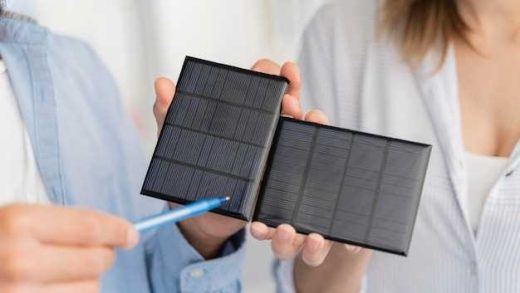
The pursuit of renewable energy sources has become an increasingly urgent matter in today’s society, as we strive to reduce our reliance on fossil fuels and mitigate the impacts of climate change. Among these alternative energy solutions, solar energy stands tall as a beacon of hope. Researchers, engineers, and innovators from around the world have been working tirelessly to enhance the efficiency of solar panels and drive the advancement of solar power generation.
Through continuous experimentation and groundbreaking discoveries, the field of solar energy has witnessed remarkable progress. The focus has been on pushing the limits of what solar panels can achieve, seeking out new techniques and materials to optimize their performance and harness sunlight more effectively. These advancements have resulted in significant increases in energy conversion rates and have paved the way for a future powered by clean, renewable energy sources.
One of the most intriguing breakthroughs in solar energy efficiency involves the development of novel photovoltaic materials. Scientists have veered away from conventional silicon-based solar panels and explored the potential of alternative substances such as perovskite, quantum dots, and organic polymers. These materials exhibit unique properties that make them more apt at capturing and converting solar energy, offering the promise of even higher efficiency and lower production costs. As a result, solar energy could become increasingly accessible and affordable for individuals, businesses, and communities alike.
Breakthroughs in Photovoltaic Technology
Recent advancements in the field of photovoltaic technology have revolutionized the way we harness and utilize solar energy. Innovative breakthroughs in this area have led to significant improvements in the efficiency and effectiveness of solar panels, paving the way for a more sustainable and reliable source of clean energy.
Enhanced Efficiency
One of the key breakthroughs in photovoltaic technology is the development of highly efficient solar cells. These cells are designed to maximize the conversion of sunlight into electricity, allowing for increased power output from each panel. Through the use of advanced materials and manufacturing techniques, researchers have been able to push the boundaries of efficiency, achieving higher conversion rates and reducing energy losses.
Improved Durability
In addition to enhanced efficiency, breakthroughs in photovoltaic technology have also focused on improving the durability and longevity of solar panels. By developing new materials and coatings, scientists have been able to create panels that are more resistant to environmental factors such as moisture, temperature fluctuations, and physical damage. This increased durability not only extends the lifespan of solar panels but also ensures their performance remains optimal over time.
- Advanced Materials: Researchers have explored the use of novel materials, such as perovskite, that offer improved light absorption and conversion capabilities.
- Multi-Junction Solar Cells: Breakthroughs in multi-junction solar cells have allowed for the capture of a broader range of sunlight wavelengths, increasing overall efficiency.
- Transparent Solar Panels: The development of transparent solar panels enables their integration into windows and other surfaces without compromising aesthetics.
- Flexible Solar Cells: The advent of flexible solar cells provides new opportunities for their integration into various applications, including curved surfaces and wearable devices.
These breakthroughs in photovoltaic technology are driving the advancement of solar power generation, making it an increasingly viable and sustainable solution for meeting our energy needs. As research and development in this field continue, we can expect further innovations that will continue to improve the efficiency, durability, and cost-effectiveness of solar panels, enabling a brighter and greener future.
Enhancing Solar Cell Efficiency with Perovskite Materials
Maximizing the effectiveness of solar cells is a key goal in the field of sustainable energy. One promising avenue for achieving this is through the integration of perovskite materials. These innovative substances have the potential to significantly enhance the efficiency of solar energy generation, ushering in a new era of clean and efficient power production.
Understanding Perovskite Materials
Perovskite materials are a class of compounds that display unique properties ideal for solar cell applications. These materials can be easily synthesized, offering a cost-effective solution for improving solar panel efficiency. Moreover, their crystalline structure allows for efficient light absorption and charge transport, enabling higher conversion rates of solar energy into electricity.
The Advantages of Perovskite-based Solar Cells
Integrating perovskite materials into solar cells brings forth several advantages. Firstly, perovskite-based solar cells exhibit a high absorption of sunlight across a wider range of the electromagnetic spectrum, enabling them to capture more solar energy. Additionally, these materials can be engineered to be highly efficient in converting sunlight into electrical energy, rivaling the performance of traditional silicon-based solar cells. Perovskite-based solar cells also offer the potential for low-cost production, making solar power more affordable and accessible to a wider range of consumers.
The utilization of perovskite materials in solar cell technology marks a significant step forward in the pursuit of sustainable energy solutions. With their remarkable efficiency and cost-effectiveness, perovskite-based solar cells hold great promise for accelerating the adoption of solar power on a global scale, fostering a more environmentally friendly future.
Harnessing the Power of Tandem Solar Cells
The utilization of tandem solar cells represents a groundbreaking approach in the realm of renewable energy. By combining the prowess of multiple solar cell technologies, this innovative solution aims to maximize the efficiency and yield of solar power generation. Tandem solar cells are designed to harness a wider spectrum of sunlight, enabling them to convert a broader range of wavelengths into electricity.
One of the key benefits of tandem solar cells is their ability to surpass the limitations of traditional single-junction solar cells. These traditional cells can only convert a specific range of wavelengths, limiting their effectiveness in capturing the full potential of solar energy. Tandem solar cells, on the other hand, utilize multiple layers of semiconductors with different energy bandgaps to capture a more extensive spectrum of incoming light.
This unique configuration allows tandem solar cells to achieve higher conversion efficiencies compared to their traditional counterparts. By combining materials that are specifically optimized for absorbing different wavelengths of light, these cells can work in tandem to extract more energy from sunlight. The ability to capture a broader range of photons translates into increased electricity production and ultimately improved overall solar power generation.
Furthermore, tandem solar cells excel in overcoming the inherent efficiency limitations of certain semiconductor materials. By layering different materials with complementary bandgap energies, tandem cells can effectively utilize a wider range of photons, thus mitigating energy loss and enabling higher conversion efficiencies. This approach also enables the use of lower-cost materials in tandem cell construction, further driving down the overall cost of solar power generation.
In summary, the harnessing of tandem solar cells presents a transformative advancement in the field of renewable energy. By capitalizing on the strengths of multiple solar cell technologies, these cells offer the potential for significantly improved efficiency and increased electricity production. As the pursuit of sustainable energy intensifies, tandem solar cells are poised to play a pivotal role in driving the widespread adoption and utilization of solar power for a greener future.
Revolutionary Solar Panels: Thin-Film and Flexible Designs
Introducing groundbreaking advancements in the field of solar technology, this section explores the game-changing potential of thin-film and flexible solar panels. These innovative designs, characterized by their sleek and lightweight construction, herald a new era in solar power generation.
Thin-Film Solar Panels: A Leap Forward in Efficiency
With a focus on maximizing efficiency, thin-film solar panels have emerged as a remarkable alternative to traditional solar panel designs. Utilizing ultra-thin semiconductors, these panels have the advantage of being both lightweight and flexible, allowing for versatile application possibilities, including integration into a variety of surfaces with ease.
Furthermore, thin-film solar panels employ innovative manufacturing techniques that result in lower material, production, and installation costs compared to their bulkier counterparts. Their improved efficiency allows for higher energy output, making them an attractive option for applications where space constraints and portability are key factors.
Flexible Solar Panels: Adapting to a Changing World
In response to the growing demand for renewable energy solutions that can adapt to various environments, flexible solar panels have emerged as a groundbreaking solution. These panels are designed to bend and conform to different surfaces, enabling their use in unconventional settings such as curved roofs, mobile devices, and even clothing.
The flexibility of these panels opens up a wide range of possibilities for solar integration, allowing for seamless incorporation into everyday objects to harness solar energy more efficiently. Furthermore, their lightweight nature and durability make them ideal for portable applications, providing a viable solution for powering devices on the go.
Both thin-film and flexible solar panels represent a significant leap forward in solar technology, offering increased efficiency, versatility, and cost-effectiveness. By revolutionizing the way we think about solar power generation, these advancements bring us closer to a sustainable and renewable future.
Maximizing Efficiency through Concentrated Solar Power Systems
Enhancing the productivity of solar energy systems can be achieved through the implementation of Concentrated Solar Power (CSP) technology. This innovative approach utilizes the power of focused sunlight to generate electricity and significantly improves the overall efficiency of solar power generation.
By harnessing the potential of concentrated solar radiation, CSP systems employ a variety of optical devices and tracking systems to redirect sunlight onto a central receiver. This concentrated heat energy is then converted into electricity through various mechanisms, such as steam cycles or thermodynamic processes. Unlike traditional solar panels that rely solely on photovoltaic cells, CSP systems enable the utilization of high-temperature heat to drive turbines and boost power generation.
One of the key advantages of employing CSP systems is their ability to store thermal energy. By incorporating advanced thermal storage technologies, such as molten salt storage or phase change materials, excess energy generated during peak sunlight hours can be stored and utilized during periods of low or no sunlight. This ensures a steady power supply and greatly enhances the overall efficiency of the system.
Moreover, the use of advanced optical materials and coatings plays a crucial role in maximizing the concentration of solar radiation. Materials with high reflectivity and low absorption properties allow for efficient light capture and minimize energy losses. Additionally, innovative design concepts, such as parabolic troughs, heliostats, or solar power towers, optimize the concentration of sunlight, further enhancing system efficiency.
The implementation of CSP systems not only increases the overall efficiency of solar energy conversion but also expands the range of applications. In addition to large-scale power plants, CSP technology can be utilized in decentralized systems, such as hybrid solar-fossil fuel installations or standalone systems for remote areas. This versatility allows for the widespread adoption of concentrated solar power and contributes to the growth of renewable energy resources.
- Harnesses the power of focused sunlight
- Utilizes advanced optical devices and tracking systems
- Enables utilization of high-temperature heat for power generation
- Incorporates thermal storage technologies for steady power supply
- Maximizes concentration of solar radiation with innovative materials and designs
- Expands range of applications in decentralized solar systems
Overcoming Obstacles: Improving Solar Efficiency in Challenging Environments
In the quest for sustainable energy sources, solar power has emerged as a promising solution. However, harnessing the sun’s energy efficiently in challenging environments poses significant obstacles that need to be overcome. This section explores innovative approaches in improving solar efficiency despite difficult conditions.
In challenging environments with limited sunlight or extreme weather conditions, traditional solar panels often face reduced performance or complete inefficiency. This necessitates a new wave of technological advancements to enhance solar efficiency in these conditions. Innovative strategies such as advanced light-trapping designs, improved materials, and optimized installation techniques are being developed to tackle these challenges.
One key focus area is improving solar efficiency in regions with high humidity or heavy cloud cover, where radiation intensity is reduced. Researchers are exploring novel materials that enable better absorption and utilization of diffuse light, ensuring optimal energy conversion even under low-intensity sunlight. Additionally, specialized coatings and surface treatments are being developed to minimize surface reflections and maximize light absorption, thereby enhancing overall solar efficiency.
Another obstacle lies in environments with extreme temperatures, such as deserts or arctic regions. These conditions can negatively impact the performance of solar panels, leading to reduced energy output. To address this, innovative cooling techniques and thermal management systems are being integrated into solar panel designs to maintain optimal operating temperature and prevent efficiency losses. These advancements enable solar panels to withstand extreme temperature variations and continue generating power reliably.
Furthermore, remote and off-grid areas often present logistical challenges for solar installations, hindering the widespread adoption of this renewable energy source. Innovations in portable, lightweight solar panels and modular systems are revolutionizing solar power generation in these environments, making it more accessible and feasible. These solutions allow for quick and easy deployment of solar infrastructure, enabling off-grid communities and remote locations to benefit from sustainable energy generation.
Overcoming obstacles and improving solar efficiency in challenging environments is crucial to unlocking the full potential of solar power generation. Through continuous innovation and research, the development of advanced technologies and adaptable solutions, solar energy can be harnessed efficiently even in the most demanding conditions, paving the way for a sustainable and greener future.


